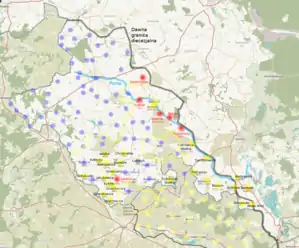Lach dialects
The Lach dialects, also known as Lachian dialects (Czech: lašská nářečí, laština, Polish: gwary laskie), are a group of West Slavic dialects that form a transition between the Polish and Czech language. They are spoken in parts of Czech Silesia, the Hlučín Region, and northeastern Moravia,[1] as well as in some adjacent villages in Poland.[2] Most Czech researchers consider Lach a dialect of Czech, whereas Polish dialectologists tend to ascribe Polish origins to Lach.[3]


Lachian is divided into numerous subdialects (Western, Eastern and Southern), it can therefore also be regarded as a dialect continuum, with limited mutual intelligibility between the eastern and western dialects. This dialectal differentiation is not typical for the Czech Republic, where there is a good deal of dialect leveling, especially in the west of the republic.
Most Lachs, especially younger speakers, now speak standard Czech, and use it as a written language, while Lach remains the language of everyday speech. Lachian contains many German loanwords, according to some sources, up to 8% of the vocabulary.
The poet Óndra Łysohorsky is probably the best-known writer in a Lachian dialect. Łysohorsky was notable for refusing to write in Standard Czech, instead writing in the local dialect of Upper Silesia. In doing so, he contributed significantly to the development of the Lach literary language.[4]
Example text
| Example text (Óndra Łysohorsky)[5] | |||
|---|---|---|---|
| Lach | Czech | Polish | English |
| Lašsky jazyk, w širokych rysach, je młuva ludu w sewerowychodnej Morawě, w starym "Rakuskym Ślónsku" a w Hučinsku. Od zapadniho jazyka českeho a połedniho jazyka slowénskeho śe rozeznowo hławně akcéntém na předostatni słabice, od wychodniho jazyka polskeho hławně ňedostatkém nosowych samohłosek | Lašský jazyk, v širokých rysech, je řeč lidí na severovýchodní Moravě, ve starém "Rakouském Slezsku" a na Hlučínsku. Od západního jazyka českého a jižního jazyka slovenského se rozezná hlavně akcentem na předposlední slabice, od východního jazyka polského hlavně nepřitomností nosových samohlásek | Język laski, w szerokim zarysie, to mowa ludu na północno-wschodnich Morawach, na starym "Śląsku Austriackim" i na ziemi hulczyńskiej. Od zachodniego języka czeskiego i południowego języka słowackiego różni się przede wszystkim akcentem na przedostatnią sylabę. Od wschodniego języka polskiego w szczególności nieobecnością nosowych samogłosek. | The Lachian language, generally characterised, is the speech of the people of northeastern Moravia, old "Austrian Silesia", and the Hlučín district. It is distinguished from the Czech language in the west and the Slovak language in the south chiefly by the stress on the penultimate syllable, from the Polish language in the east chiefly by the absence of nasal vowels. |
See also
Footnotes
- Hannan 1996, 726.
- Hannan 1996, 730.
- S. Bąk, Mowa polska na Śląsku, Wrocław and Warsaw 1974.
- Hannan 1996, 726.
- Hannan 1996, 726.
References
- Hannan, Kevin (Winter 1996). "The Lachian Literary Language of Óndra Łysohorsky". The Slavic and East European Journal. 40 (4): 726–743. doi:10.2307/310109. JSTOR 310109.